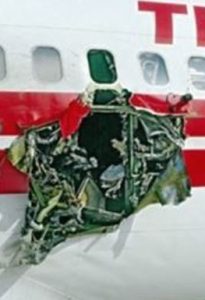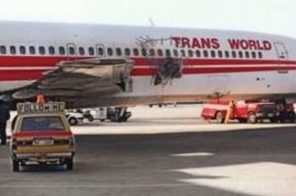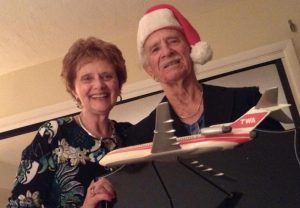 For a time, bombs or bomb threats seemed to be the weapon of choice for terrorists and hijackers on the worlds airlines. With better screenings and luggage checks, things have improved and we see fewer incidences like these, but that in no way means that we should ever let our guard down, because evil exists in this world, and awareness of that fact saves lives. On April 2, 1986, we weren’t quite as prepared as we are today. On that day, Trans World Airlines Flight 840 was on a regularly scheduled flight from Los Angeles to Cairo via New York City, Rome, and Athens. The plane was flying at 11,000 feet over Greece, on its way to Athens, when the bomb went off. Four people, including an eight-month old baby, were sucked out of a TWA passenger jet after an explosion ripped a hole in its side.
For a time, bombs or bomb threats seemed to be the weapon of choice for terrorists and hijackers on the worlds airlines. With better screenings and luggage checks, things have improved and we see fewer incidences like these, but that in no way means that we should ever let our guard down, because evil exists in this world, and awareness of that fact saves lives. On April 2, 1986, we weren’t quite as prepared as we are today. On that day, Trans World Airlines Flight 840 was on a regularly scheduled flight from Los Angeles to Cairo via New York City, Rome, and Athens. The plane was flying at 11,000 feet over Greece, on its way to Athens, when the bomb went off. Four people, including an eight-month old baby, were sucked out of a TWA passenger jet after an explosion ripped a hole in its side.
It blew a hole six feet by three feet wide under a window in front of the starboard wing. It is believed the explosion happened at floor level in the passenger compartment itself. The four bodies of the victims were retrieved from a site 87 miles southwest of Athens. Three were from the same Greek-American family, believed to have been a grandmother, her daughter and her granddaughter. Police also found the body of a male passenger identified as a Colombian-born American, sucked out of the plane still in his seat. Remarkably, the remaining 118 passengers and crew survived, including Christian author, Jeanette Chaffee, who has written about this and other incredible situations, called “Extravagant Graces,” a book I think I will have to read. The pilot, Captain Richard Petersen, made an emergency landing, telling Athens control tower that the pressurization in the cabin was failing.

The pilot, Captain Richard Petersen, made an emergency landing, telling Athens control tower that the pressurization in the cabin was failing. He is being hailed as a hero. “We are proud of him,” said a TWA source. Just seven passengers were taken to hospital, and only three were kept in for treatment. One was Ibrahim al-Nami, from Saudi Arabia, who said he had been sitting next to the man who was sucked out with his seat. “We heard a big bang outside the window,” he said,” and then I saw the man next to me disappear and I felt myself being pulled out.” He avoided sharing the same fate by clinging on to his wife’s seat. Another passenger escaped because she left her seat only minutes earlier to go to the lavatory. Florentia Haniotakis, a Greek-American from Ohio, praised the crew. She says they comforted passengers to calm them during the emergency landing.
The airliner was on the same Rome-Cairo route as a similar TWA plane hijacked by Shia Muslim gunmen in June 1985 after leaving Athens for Rome. The investigation found that the bomb had been planted under seat number 10F, probably inside a lifejacket. A group calling itself the Ezzedine Kassam Unit of the Arab Revolutionary Cells claimed responsibility, and said the bombing was in retaliation for US bombing raids against  Libya the previous month. Police initially suspected a Lebanon-born Palestinian woman named Mai Elias Mansur. Mansur was a suspected terrorist connected with the Abu Nidal extremist group, who was involved in an abortive attempt to bomb a Pan American airliner in 1983. She had travelled in seat 10F on an earlier flight of the same Boeing 727. Mansur denied any involvement. After a two year investigation, the US State Department said it believed that she had carried out the bombing, operating on the orders of known Palestinian terrorist Colonel Hawari, but they were unable to definitively prove it. Therefore, nobody has ever been convicted of carrying out the bombing. TWA filed for bankruptcy in 2001 and was taken over by American Airlines.
Libya the previous month. Police initially suspected a Lebanon-born Palestinian woman named Mai Elias Mansur. Mansur was a suspected terrorist connected with the Abu Nidal extremist group, who was involved in an abortive attempt to bomb a Pan American airliner in 1983. She had travelled in seat 10F on an earlier flight of the same Boeing 727. Mansur denied any involvement. After a two year investigation, the US State Department said it believed that she had carried out the bombing, operating on the orders of known Palestinian terrorist Colonel Hawari, but they were unable to definitively prove it. Therefore, nobody has ever been convicted of carrying out the bombing. TWA filed for bankruptcy in 2001 and was taken over by American Airlines.


Leave a Reply